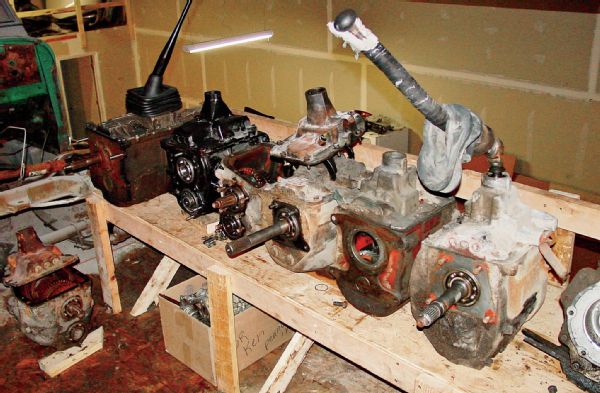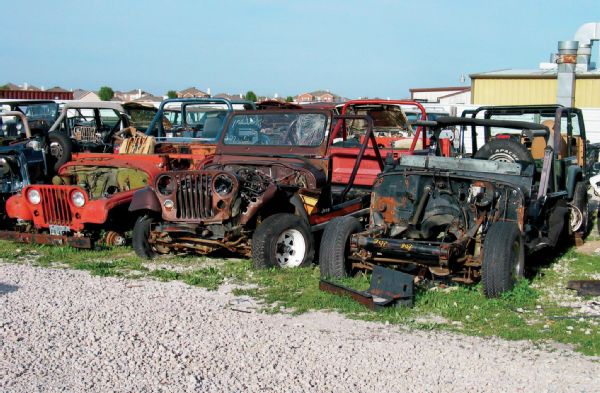
 John Cappa
Former Editor, Four Wheeler
John Cappa
Former Editor, Four Wheeler
Troublesome T-90
I swapped out my 226ci Super Hurricane for a built ’81 AMC 258ci inline-six. I have adapted the bellhousing to work with my T-90 transmission. Is this a common swap? (You do get heat and defrost!) This has been a pretty good swap, but I am curious if I am tempting fate by putting the extra horsepower in front of my little T-90. There is now enough horsepower to convert a lot of atheists for that stock suspension! Also, I acquired another T-90 and Spicer 18 transfer case with a Borg-Warner overdrive that I’d like to drop in. Any pointers?
Greg Asiala
Via email

The T-90 transmission can be found in many older Jeeps built between the mid ’40s and early ’70s. There are lots of adapters available that mate the T-90 to more powerful engines, even V-8s. The 9-inch-long T-90 transmission is incredibly durable for its size, but it’s not bombproof. The biggest drawback is probably the fact that it’s a three-speed with a non-synchronized First gear. It makes the transmission less drivable both on- and off-road. A larger truck-type transmission such as the T-18, SM420, SM465, NV4500, and others offer more strength, durability, and drivability. That’s not to say the T-90 will fail you. If you drive your Jeep sanely, it will likely last many years. Hard street launches and bouncing up loose climbs off-road could cause the T-90 problems in your application. Just keep in mind that it is a comparatively small transmission and you shouldn’t have any issues. If you decide that you want to run larger tires and deeper First gear for more control on technical trails, consider one of the above mentioned truck transmissions. Advance Adapters (advanceadapters.com), Novak Conversions (novak-adapt.com), and Herm the Overdrive Guy (hermtheoverdriveguy.com) offer adapters and even completely rebuilt transmissions to help you make the swap.
Be careful when swapping T-90 transmissions. There are two different input shaft lengths, and some T-90s feature more desirable gear ratios than others. Your six-cylinder Jeep requires a T-90 with a 9.25-inch-long input shaft. Not all of the internal parts are interchangeable so know what you have before tearing into the swap.
Shuddering
I am the second owner of a stock ’83 CJ-8 wagon with an honest 40,000 miles on it. The Jeep has a problem that is driving me nuts. It has the original inline-six with a five-speed manual transmission. It rides on 31x10.50 tires. The Jeep is not lifted but it has the original heavy-duty spring package and a winch. When it is being driven for 60 miles or more, it starts to shudder violently when accelerating from a standstill in First or Reverse gear. It seems to do this only when something is getting warm enough to cause the problem. I replaced the clutch disc and pressure plate. The flywheel was within specs. I replaced the pilot bearing and adjusted the clutch-linkage. I changed the motor and transmission mounts, all the gear oils, and thoroughly inspected the engine. I replaced the complete ignition system with a D.U.I. distributor, spark plugs, and wires, removed the carburetor deceleration valve because it seemed to be leaking, and replaced all vacuum hoses and hooked ’em up like it came from the factory. I also cleaned the original carburetor and changed all the filters. The previous owner, a Swiss fire department, also had the rear driveshaft sent to a repair shop. Being a Jeep family, my father has a ’81 stock CJ-7 with an inline-six and a four-speed transmission that I compared mine with. Even when the symptoms are not present, my dad’s Jeep seems to accelerate better than mine and everything else appears to be the same. I am really at my wit’s end and I don’t know where to look next. Can you please help me with this?
Bernd
Wels, Austria
It sounds like your flywheel needs to be resurfaced. The clutch wears on the flywheel. This creates heat. Over time, the flywheel is no longer perfectly flat. These bumps in the flywheel surface will cause the clutch to chatter. That’s why you only notice it at slow speeds. At highway speeds, you don’t have to slip the clutch much when shifting.
You should always resurface the flywheel prior to installing a new clutch. I recommend replacing the clutch again, but this time, send the flywheel out to be resurfaced. While you are in there, check for and repair any oil leaks coming from the rear main seal and valve cover. If oil gets on the clutch, it can cause the problems you are having. When you reinstall the flywheel and clutch, make sure to torque everything to spec and use a clutch alignment tool to center the disc.
As far as an ’81 CJ-7 accelerating more quickly than your ’83 CJ-8 wagon, there are many variables to consider. The CJ-7 is likely a little lighter. The Jeeps have different transmissions (with different ratios), and who knows what gear ratios are in the axles. All of this could lead to considerably different acceleration speeds between the two Jeeps. The chattering clutch will have little to do with your Jeep being a bit slower than the CJ-7.
Entry-Level XJ
I have a bone stock ’01 XJ with 30x9.50 tires (just pitiful). I want to start out with a 3-inch Rusty’s spring lift and track bar, but I don’t know what to expect for handling or alignment issues? Later on, I’d like to upgrade to a TnT Customs long-arm kit. Any words of wisdom on a spring lift with stock control arms?
Calvin Splan
Via email

The basic 3-inch Rusty’s Off-Road (rustysoffroad.com) XJ lift kit is a great inexpensive starter kit to get your Jeep going in an upward direction. The addition of the track bar is a good idea. The stock steering on TJs, XJs, MJs, and ZJs is pretty spindly. I would also seriously consider the Currie Enterprises (currieenterprises.com) Currectlync heavy-duty steering system. I’ve seen many stock tie rods and drag links bend on the trail. Also, anything over about 3 inches of lift can cause the factory tie-rod ends to bind at full suspension droop. The Currie steering kit not only provides beefier steering links, the tie-rod ends allow for more angularity. Down the road, when your lift gets bigger, you’ll want to swap in a transfer case slip-yoke eliminator kit and CV driveshaft to alleviate the driveline vibration that increased angularity causes.
Two Confirmed Buyers of a Diesel JK
My husband and I plan to buy a diesel JK if the new engine proves worthwhile in the Cherokee. The question is: Are we better off buying an inexpensive model and adding all the goodies for wheeling or buying a Rubicon to start? We are conservative drivers but enjoy rockcrawling. We currently flat tow or drive our ’99 TJ to 4x4 locations and will do the same with the new vehicle. We are looking for a little more comfort, mileage, storage, and passenger space in the JK. Your advice would be appreciated.
Deanna Schnabel
Via email
Well Deanna, unless you know more about the 2016 Wrangler than we do, getting a JK with a diesel is gonna have to come in the form of a custom-built rig. Otherwise, if for some reason we are wrong about the 2016 JKs coming from the factory with a diesel, you can bet that we will be in line with you at dealership to buy one. Having said that, we’ve been hearing rumors about diesel Wranglers from the factory since the middle of the last decade, so don’t expect us to keep holding our breath. We fear that the only way to get a Wrangler with a diesel may be to keep waiting and hoping or start a conversion.
We also assume you are referring to the 3.0L EcoDiesel in the ’13-present Grand Cherokee, which may or may not (probably not) ever be available in an open-top Jeep from the factory (in the USA, that is). That is an awesome engine and is available as an engine/transmission/transfer case package from Banks Power. So, if you have to have a diesel JK, I would probably suggest starting with a used JK that has a bad gasoline engine. Then, you can get a deal on the Jeep that will help offset the rather large cost of the Banks package. You are then going to have to swap the engine into the JK and get it running. Oh, and you’ll have to live in an area of the country where you either don’t have to worry about emissions inspections or can somehow sidestep them. The emissions Nazis won’t like this swap, in spite of the fact that the new 3.0L Eco Diesel is more efficient and puts out fewer emissions than the JK gasser motors.
To answer your question about whether to start with a loaded Rubicon or a base model JK, that is really up to you and what you plan to do with the Jeep. If you intend to run 37-inch or larger tires, the Rubicon axle parts (that really make the Rubicon a Rubicon) may not be durable enough for your Jeep. By that we mean that you may want larger, stronger axles and axle components. In that case, you’d probably be better off starting with a non-Rubicon JK and building axles for it to accommodate larger tires and the diesel engine conversion.
Old Iron Scavenger Hunt
I recently purchased a ’73 AMC CJ-5 that has been sitting in a garage for four years. It has a 304ci V-8 with a three-speed transmission. Being an old shade-tree mechanic from the late ’60s, I knew that AMC bastardized everything during that timeframe. Your response to Chris Steed (Your Jeep, Oct. ’14) cleared up many questions I had. My Jeep does have the under-seat toolbox. However, one question still remains. I have noticed that it is difficult to locate aftermarket parts for the ’72-’75 CJ. Why is this? Based on your article, it looks like I should aim for ’71 and earlier. Could you please advise me if this is correct or not?
Det. Terrence Rooney (Ret)
Clinton Township, MI Police Dept.

Why do the aftermarket parts for older Jeeps dry up? It’s really as simple as supply and demand. There are fewer older Jeeps around, so fewer people buy parts and modify the Jeeps. Most aftermarket manufacturers move their efforts to newer, more plentiful models. Over the last couple of decades, we’ve seen many extremely popular older Jeep aftermarket parts become discontinued. Does anyone even offer a flatfender bikini top anymore? The good news is that Omix-Ada (omix-ada.com) offers a lot of the factory replacement components for every older Jeep, along with a few upgrades. There are also smaller companies that specialize in the older Jeeps. Take Beachwood Canvas Works (beachwoodcanvas.com) for example. The company is well known for producing high-quality tops and seat covers that look factory new. You can still find lift kits and shocks, but most of the simple bolt-on goodies are long gone. Old Jeep owners have found ways to modify the parts designed for newer models, or in some cases, they have simply learned to build exactly what they want from scratch.
Write Us!
Got a tech question you’re just itching to get answered? Send it on in to Jp Magazine, Your Jeep, 831 S. Douglas St., El Segundo, CA 90245, or e-mail it to jpeditor@jpmagazine.com.